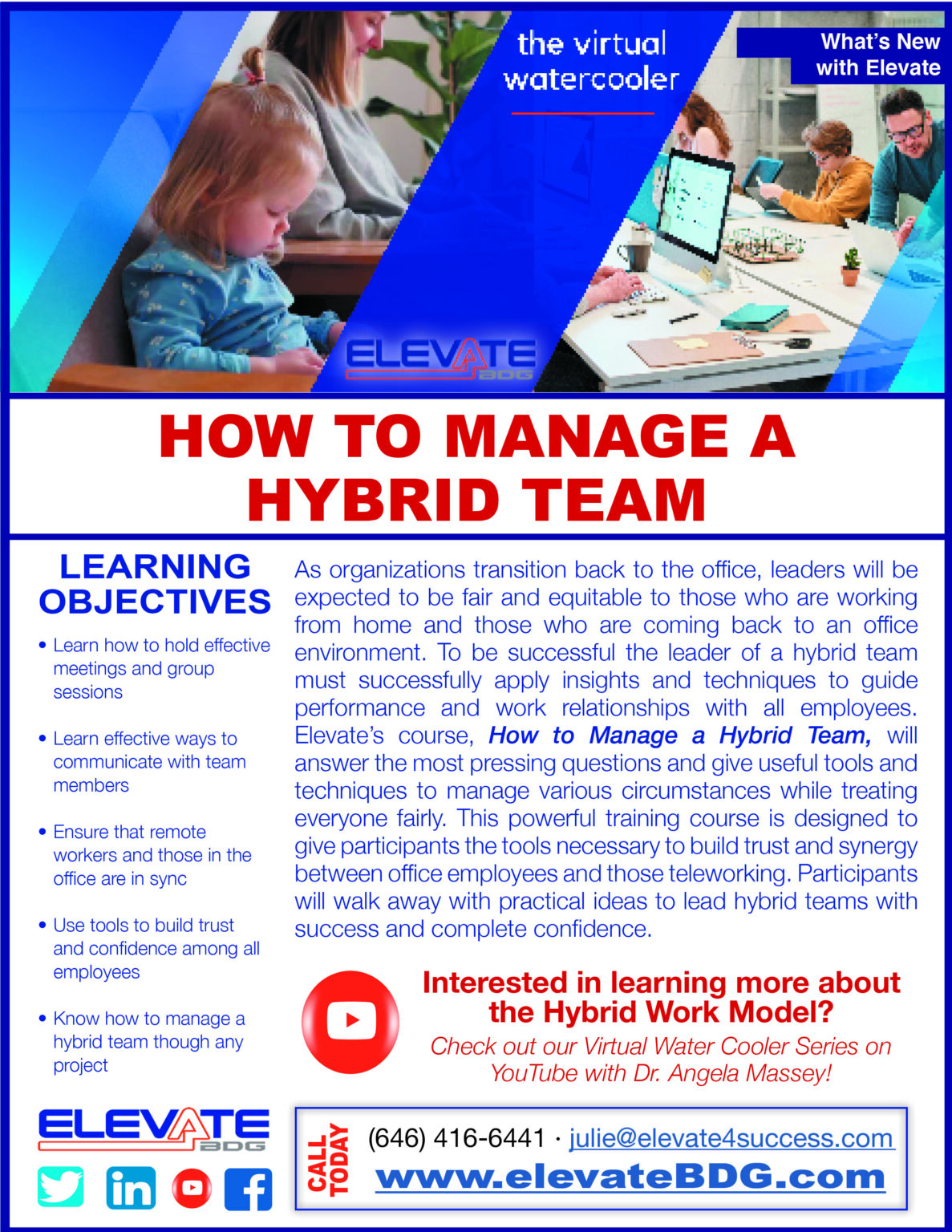Not all individuals are equally skilled at operating within a hybrid environment, and some jobs are just better done on-site, making hybrid work ideal for some members of your team and not for others. It is the leader’s job to ensure that all employees are treated fairly and that your hybrid work model does not create an “us versus them” mentality among on-site and off-site colleagues. In Elevate’s Virtual Water Cooler Series on YouTube, Dr. Angela Massey presents 2-minute tips for business leaders that explore the ins and outs of running a successful hybrid team. In this week’s episode, we will explore how you can make sure your employees feel appreciated and recognized in today’s hybrid workplace.
As a digital marketer, I have had the luxury of working from home for some time. As long as I have a computer and working internet, I function best with minimal distractions and flexibility in my schedule. I am the mother of two young children and can’t fathom how I could juggle a traditional 9-5 at this point in my life. While remote work has its obvious perks, it definitely comes with some struggles.
Creativity is a key element as a writer and designer and the solitude of working from home can leave me blank sometimes. As much as I cannot see myself in a traditional office setting at this stage of my life, I miss the opportunity to build workplace relationships with my peers and pop my ideas off of others. I find myself pacing aimlessly around my house some days looking for inspiration, as compared to my years in an office setting where I was able to seek help from others in a more direct fashion.
Even though the remote workforce was nothing new to me, like most of the world, 2020 impacted my “Work From Home” routine. I suddenly had two kids breathing down my neck as I attempted to perform tasks that required uninterrupted thought. Alas, I survived and was fortunate enough to have my children back in daycare within four months. But most families were not as lucky.
Even as companies began to open back up, many parents still had children at home, making it impossible for them to return to the office on a permanent basis. With the CDC now anticipating that the nation’s school kids will be returning to the classroom in the new school year, many companies are trying to navigate a smooth return to office in a hybrid work environment. While returning to the cubicle brings back a sense of normalcy to our lives, more than 65% of today’s employees are now wanting a more flexible work schedule. For businesses throughout the world, the traditional Monday – Friday, 9-5 work model is quickly shifting to a more flexible hybrid model, allowing employees to work both from home and in the office.
As a business leader, you will be in charge of creating a cohesive work environment where everyone is treated equally, whether they are working on-site, hybrid, or remote.
Every employee is different, which can make this task difficult.
Tips for Leaders to Make the Hybrid Transition Successful
For 2 minute tips on leading a successful hybrid team, visit our Virtual Water Cooler on Elevate’s YouTube page!
-
Be Flexible – Remember that flexibility is key when you are trying to determine whether someone is better suited to work on-site or remote. Some members of your team may have personal preferences regarding how and where they work that do not align with their job responsibilities, roles, and abilities. Simply put, some roles and responsibilities are just better done on-site, so it is important to ensure that the people in these positions have personal preferences that align with their position.
-
Communicate Effectively – Minimize conflict between on-site and remote employees by understanding and trying to best accommodate each team members’ individual needs. Make sure everyone is aware of how and why you came to your scheduling decisions so no one feels like they are getting the short end of the stick. Communication is key.
-
Include Everyone – Be sure to be inclusive to ensure that you are keeping your remote employees engaged with the office happenings. Create a space where on-site and remote employees can co-mingle and share their visions with each other.





